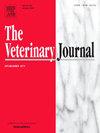吉娃娃III级髌骨内侧脱位的术前和术后关节运动:运动学和角度学分析
IF 3.1
2区 农林科学
Q1 VETERINARY SCIENCES
引用次数: 0
摘要
内侧髌骨脱位(MPL)是犬常见的骨科疾病,导致膝关节不稳定和骨盆肢体生物力学改变。虽然其对膝关节功能的影响已被广泛报道,但对相邻关节的影响以及手术矫正后的生物力学恢复过程的描述仍然很少。本研究旨在通过二维运动学和角度学分析评估患有III级MPL的吉娃娃的膝关节、髋关节和跗骨关节的主动(AROM)和被动(PROM)活动范围。17只客户拥有的吉娃娃被纳入研究,包括10只mpl感染犬和7只临床健康对照犬。MPL犬接受手术矫正,并在术前和术后2、4、6和8周进行关节运动评估。与对照组相比,MPL组的膝关节AROM和PROM显著减少,尤其是伸展部分,表明功能受损。术前还检测到髋关节和跗骨AROM代偿性增加,提示生物力学适应。手术后,膝关节AROM逐渐改善,并在第8周接近控制值,而膝关节PROM持续减少。髋关节和跗骨AROM的时间变化提示早期代偿性适应,随着膝关节功能的改善逐渐消退。然而,持续的窒息性早破局限性强调了早期、有针对性的康复的必要性。解决原发性关节功能障碍和代偿性变化的多模式策略对于优化恢复至关重要。基线关节运动数据可以作为评估手术效果和指导个性化术后护理的有价值的基准。本文章由计算机程序翻译,如有差异,请以英文原文为准。
Preoperative and postoperative joint motion in chihuahuas with Grade III medial patellar luxation: A kinematic and goniometric analysis
Medial patellar luxation (MPL) is a common orthopaedic disorder in dogs, resulting in stifle instability and altered pelvic limb biomechanics. While its effects on stifle function have been extensively documented, the influence on adjacent joints and the course of biomechanical recovery following surgical correction remain poorly characterized. This study aimed to evaluate active (AROM) and passive (PROM) range of motion in the stifle, hip, and tarsal joints of Chihuahuas with Grade III MPL using two-dimensional kinematic and goniometric analyses. Seventeen client-owned Chihuahuas were enrolled, comprising ten MPL-affected dogs and seven clinically healthy controls. MPL dogs underwent surgical correction, and joint motion assessments were performed preoperatively and at 2, 4, 6, and 8 weeks postoperatively. Significant reductions in stifle AROM and PROM, particularly in extension, were observed in the MPL group compared to controls, indicating functional impairment. Compensatory increases in hip and tarsal AROM were also detected preoperatively, suggesting biomechanical adaptation. Following surgery, stifle AROM progressively improved and approached control values by week 8, whereas stifle PROM remained consistently reduced. Temporal changes in hip and tarsal AROM suggested early compensatory adaptations, which gradually resolved as stifle function improved. However, persistent stifle PROM limitations underscore the need for early, targeted rehabilitation. A multimodal strategy addressing both primary joint dysfunction and compensatory changes is essential to optimize recovery. Baseline joint motion data may serve as valuable benchmarks for evaluating surgical outcomes and guiding individualized postoperative care.
求助全文
通过发布文献求助,成功后即可免费获取论文全文。
去求助
来源期刊

Veterinary journal
农林科学-兽医学
CiteScore
4.10
自引率
4.50%
发文量
79
审稿时长
40 days
期刊介绍:
The Veterinary Journal (established 1875) publishes worldwide contributions on all aspects of veterinary science and its related subjects. It provides regular book reviews and a short communications section. The journal regularly commissions topical reviews and commentaries on features of major importance. Research areas include infectious diseases, applied biochemistry, parasitology, endocrinology, microbiology, immunology, pathology, pharmacology, physiology, molecular biology, immunogenetics, surgery, ophthalmology, dermatology and oncology.
 求助内容:
求助内容: 应助结果提醒方式:
应助结果提醒方式:


